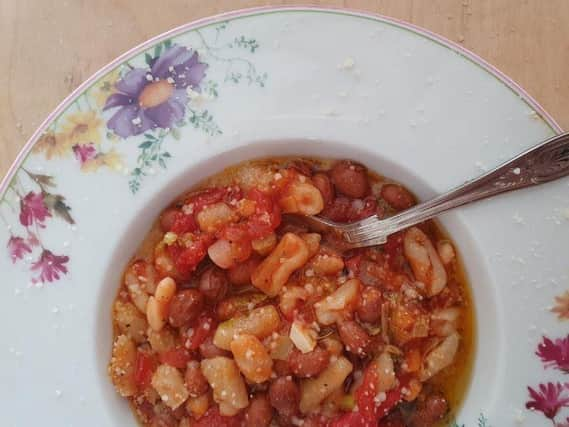How tinned food can make a pasta treat while you are safe at home...by Northampton's very own Carmela Sophia Sereno


Rationing, limited availability and a world crisis. I never thought in my lifetime I would witness such fear and sadness on mass.
My children are confused and I have no answers, but I can comfort them with love and food. It is imperative to stand strong and be thankful for what we have and look after ourselves, our friends and families, all be it at a distance.
Advertisement
Hide AdAdvertisement
Hide AdI, like many, am on a three-month lockdown due to a long-term illness and am incredibly thankful for my well-stocked Italian larder.
I am, I suppose, a bit or a hoarder, but I announce this will a smile on my face. I love tinned food! I have tinned tomatoes, beans, pulses, lentils, custard, fish and so much more.
Last week I worked alongside Filippo Berio olive oil and launched an Instagram live video, making the bread pasta and bean sauce recipe below.
Change and amend the ingredients as required, by using what you have available in your own larder or cupboard.
Substitute and enjoy. Stay safe!
Pasta Dumplings With Borlotti Beans Pisarei E Faso
Advertisement
Hide AdAdvertisement
Hide AdThere is an old wives’ tale attached to this pasta shape. The thumb is used to apply pressure to the dough, forming a dent, hence possibly leaving a tough outer skin on the thumb if they were made often enough.
If a well-used thumb was seen on a young lady, then is was said she would make a perfect wife and mother.
Pisarei (pasta dumplings) are still made by grandmothers, mothers and daughters and are from the province of Piacenza, in Emilia-Romagna.
The art of making pasta is still very much loved in Italy, especially within the family home, and I like the idea of the tale too, which adds a sense of romance.
Preparation time 1 hour; Cooking time 30 minutes (serves 4)
For The Pasta
400g ‘00’ flour
150g stale white breadcrumbs
350ml–380ml warm water
For The Sauce
2 tbsp olive oil
1 medium shallot, peeled and finely chopped
30g lard
2 garlic cloves, peeled and crushed
Small bunch of parsley, chopped
600g passata
100ml water
1 tbsp tomato purée
1 x 400g tin borlotti beans, drained
Salt and pepper to season
10 basil leaves, torn
70g Parmesan, grated
Advertisement
Hide AdAdvertisement
Hide Ad1 Into a bowl, tumble in the flour and breadcrumbs and stir.
2 Make a well in the centre and slowly add the water.
3 Form the mixture into a ball of dough using your hands.
4 Knead for 4 minutes on a lightly floured surface until elastic and smooth. Cover and allow to rest for 30 minutes.
5 Once rested, cut the dough into four portions. Roll each quarter out into thin sausage shapes. Using a knife, cut each into small pieces of dough. The pasta should not be too thick and should be the size of a swollen borlotti bean. Use your thumb to push each small piece to make a concave dent.
6 Continue making the pasta in this way. Place each dumpling on to a clean tea towel to dry a little whilst you make the sauce.
Advertisement
Hide AdAdvertisement
Hide Ad7 Into a shallow saucepan, add the olive oil and onion. Fry off the shallot for two minutes over a low heat until softened.
8 Add the lard, garlic and parsley. Stir well.
9 Pour in the passata, along with the water, tomato purée and drained borlotti beans. Stir and season with salt and pepper. Cook slowly for 30 minutes.
10 Cook the pisarei in salted water until al dente. Drain, reserving a small ladle of the starchy pasta water.
11 Add the pasta and reserved water to the sauce and stir gently. Add the basil leaves.
12 Serve in bowls with some grated Parmesan. Enjoy!
Comment Guidelines
National World encourages reader discussion on our stories. User feedback, insights and back-and-forth exchanges add a rich layer of context to reporting. Please review our Community Guidelines before commenting.